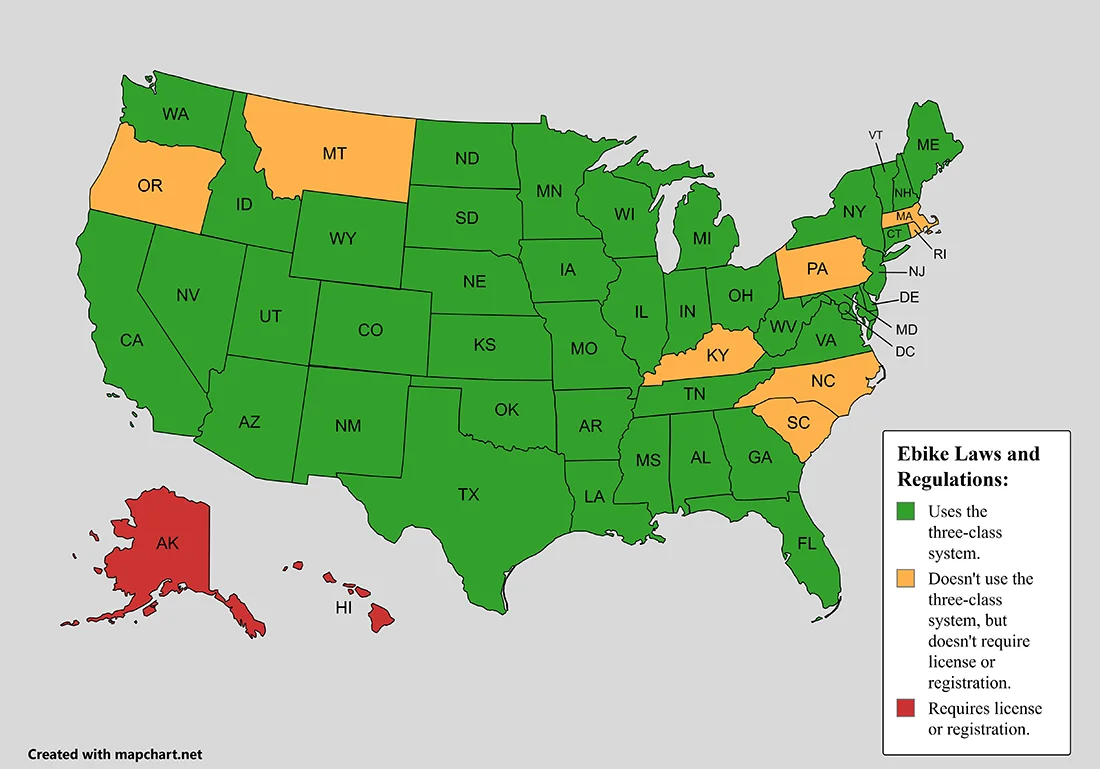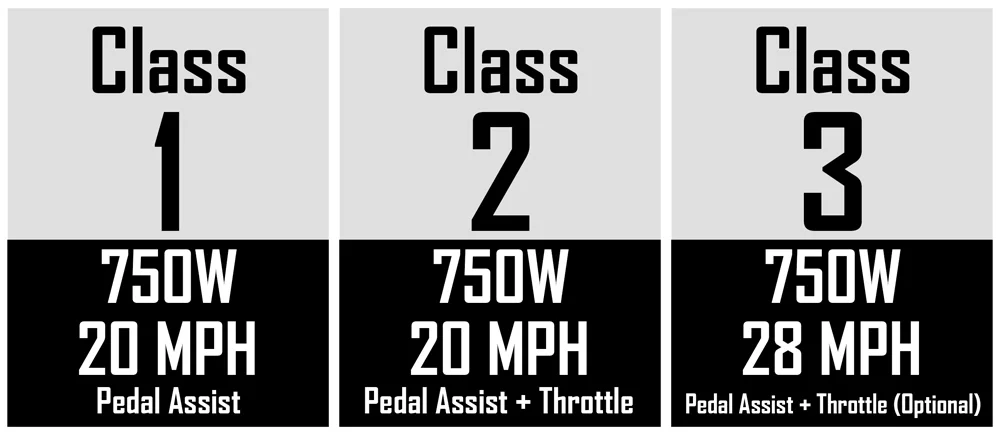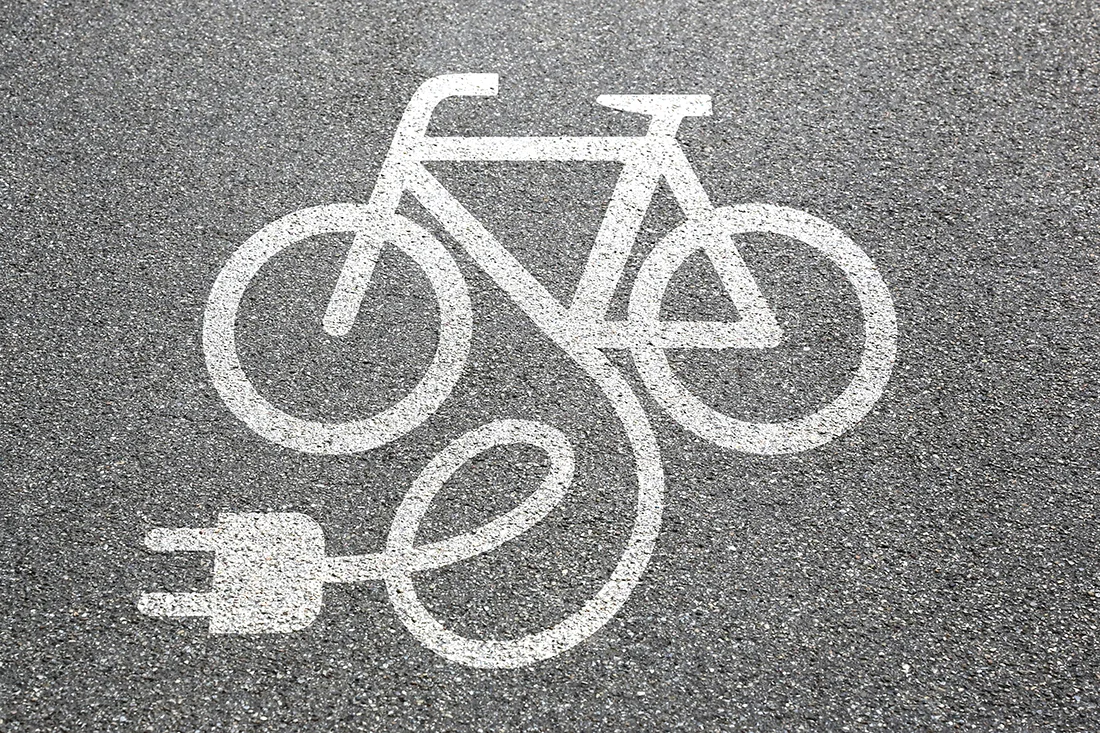Ebikes are gaining popularity because they are fun, practical, affordable and more environmentally friendly than cars. But, like so many people, you might be wondering, “Do I need a license for an electric bike?”
The short answer is: No, in most US states you do not need a license to ride an electric bike. In 48 out of 50 US states, ebikes are regulated as bicycles and don’t require licensing or registration to ride. The only two exceptions are Alaska and Hawaii—Alaska requires riders to carry an operator’s license, whereas Hawaii requires ebike owners to be registered.
Even though you don’t require licensing or registration to ride an ebike in most states, the complete answer is a bit more nuanced.
Different states have different views on what constitutes an ebike and when an ebike becomes a motorized vehicle, specifically regarding the maximum speed and motor power.
Keep reading below to learn all the details.
Contents
Do You Need a License to Ride an Ebike in the US?

As we’ve mentioned briefly above, you do not need a license to ride an ebike in the US, unless you live in Alaska. Additionally, you’ll need to register yourself as an ebike owner if you live in Hawaii, but you won’t need a license.
All other states recognize ebikes as bicycles (not as motorized vehicles) and don’t require licensing or registration. However, there are nuances within these 48 remaining states.
At the moment of writing this guide (April 2024), 40 states use the three-class system proposed by People for Bikes, whereas the remaining 8 states have their own regulatory approaches.
What Are the Three E-Bike Classes?

The three-class system is used in the majority of US states and categorizes ebikes into three groups based on their motor power, maximum speed, and the type of assistance they have.
These are:
- Class 1 Ebikes: These ebikes are allowed to use pedal assistance (PAS) only, have a 20 mph top speed and a 750W max power output.
- Class 2 Ebikes: These ebikes are allowed to use pedal assistance and throttle, have a 20 mph top speed for both and a 750W max power output.
- Class 3 Ebikes: These ebikes (also known as speed pedelecs) are allowed to use pedal assistance only, have a 28 mph top speed and a 750W max power output.
In all 40 states that currently use the three-class system, the ebikes that exceed the 750W maximum power output or the 28 mph top speed are no longer considered to be electric bicycles but become motorized vehicles and are subject to the same regulations and restrictions as mopeds and scooters.
Related guide: Complete Guide to Electric Bike Motors: Different Types Explained
Exceptions to the Three-Class Regulatory System
In addition to the 40 states that use the three-class system and the 2 states that require licensing or registration (Alaska and Hawaii), there are additional eight states with their own set of rules.
These states are Kentucky, Massachusetts, Montana, North Carolina, Oregon, Pennsylvania, Rhode Island, and South Carolina.
These states don’t require licensing or registration, but also don’t recognize the three-class system.
Check out the table below for specific rules regarding top speed, top power, age, and other requirements.
| State | Maximum Speed | Maximum Power | Age | Other rules |
Registration/Licensing
|
| Kentucky | 30 mph | 50 cc | / | Must have pedals | No |
| Massachusetts | 20 mph | 750W | 16 | Helmets required | No |
| Montana | 20 mph | N/A | / | / | No |
| North Carolina | 20 mph | 750W | 16 | Must have pedals | No |
| Oregon | 20 mph | 1000W | 16 | Must have pedals | No |
| Pennsylvania | 20 mph | 750W | 16 | 100 lb maximum weight | No |
| Rhode Island | 25 mph | 1491W (2 H.P.) | / | / | No |
| South Carolina | 20 mph | 750W | / | / | No |
| Hawaii | 20 mph | 750W | 15 | Helmets under 14 years |
Registration
|
| Alaska | / | / | 14 | Helmets not required | License |
Do You Need a License to Ride an Ebike in the EU?

The EU regulations surrounding ebikes are more stringent in terms of maximum power and speed compared to US laws.
The European Union defines an ebike as a two or three-wheel cycle with pedals and an auxiliary motor that provides pedal assistance, has a maximum continuous power of 250W, and a top speed of 25 km/h (15.5 mph).
Ebikes that fall withing these limitations are exempt from all licensing and registration requirements.
All other types of electric vehicles (including ebikes with a throttle, more power, or a higher maximum speed) require licensing and registration and are subject to the EU’s four-class moped categorization:
- L1e-A: 250-1000W max power, 25 km/h (15.5 mph) top speed, throttle optional, up to four wheels.
- L1e-B: 4000W max power, 45 km/h (28 mph), throttle optional, two wheels.
- L2e: 4000W max power, 45 km/h (28 mph), throttle optional, three wheels, 270 kg (595 lb) max weight.
- L1e-B: 45 km/h (28 mph), throttle optional, four wheels, 450 kg (992 lb) max weight.
So, to sum up, if you live in the EU, you do not need license or registration to ride an ebike as long as it has a 250W maximum sustained power and a 25 km/h (15.5 mph) maximum speed.
Can You Ride Ebikes on MTB Trails and Bike Paths?

Class 1 electric bikes are generally allowed on MTB trails, bike paths, and sidewalks across the country.
However, Class 2 and Class 3 ebikes may not have the same treatment. These are deemed as more dangerous because of throttle usage (Class 2) and the 28 mph top speed (Class 3), both of which are more suitable for road use.
But, exceptions are always possible, so it’s best to research the specific regulations in the state where you plan to ride.
Moreover, regulations on MTB trails depend on whether the trails are managed by federal, state, or local authorities, so you need to do additional research before embarking on an off-road ebike adventure.




